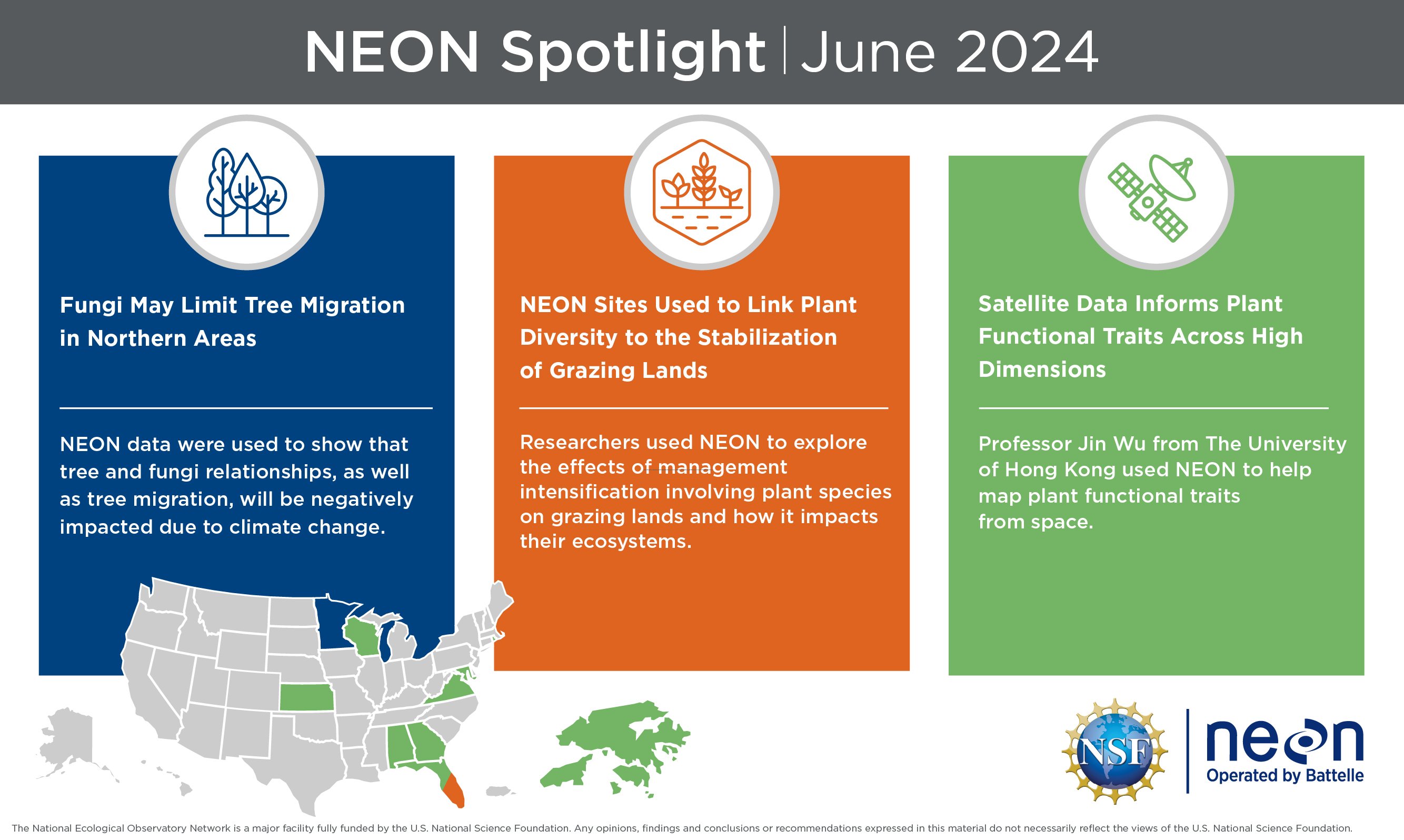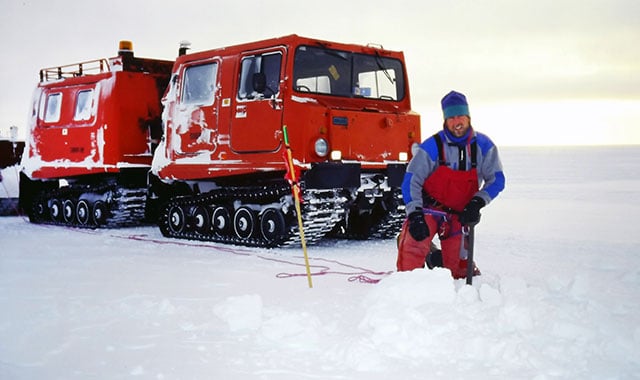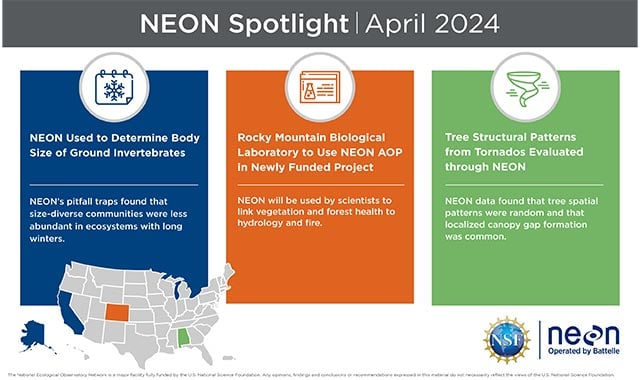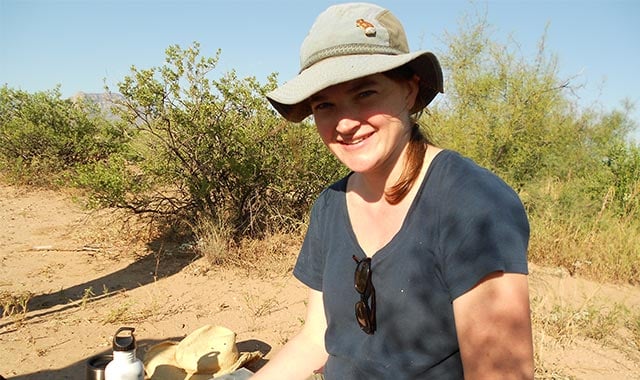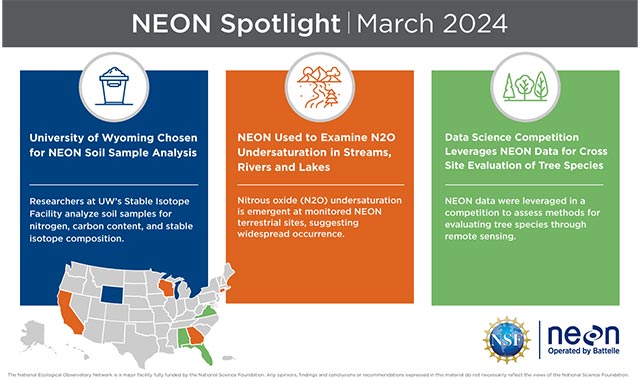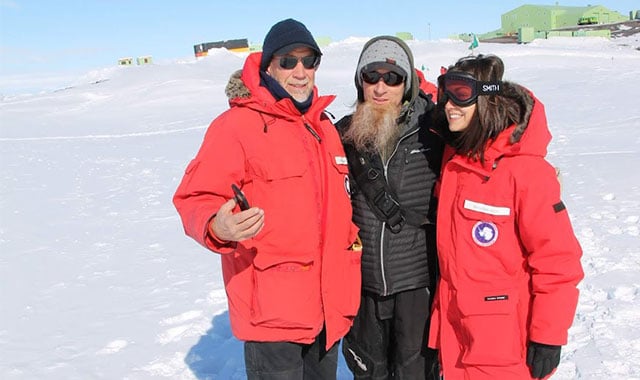NEON Spotlight: The Best of 2023
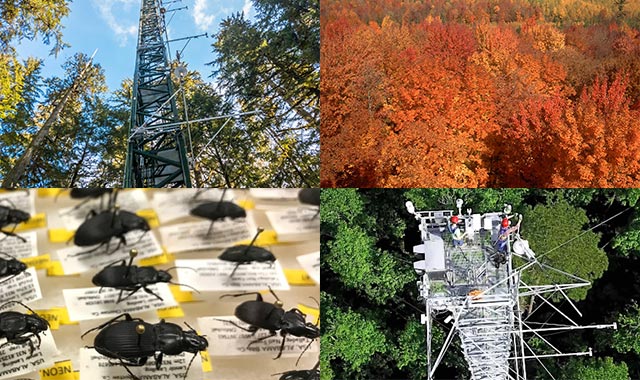
A Special Message from Battelle President and CEO Lou Von Thaer
Since 2016, Battelle has had the privilege of managing and operating the National Ecological Observatory Network (NEON) in partnership with the National Science Foundation (NSF).
Originally conceived at the turn of the millennium and designed to collect measurements for three decades, NEON is a U.S.-wide network of 81 field sites that offers the global scientific community access to rich, continent-scale datasets that are driving ecological research.
2023 was an important year for Battelle and the NEON program as a whole. 2023 was the Year of Open Science, and NEON exemplifies the open science mindset, providing free and open data, samples, and resources to all. Additionally, in September NSF announced that it was awarding the next 5 years of operations of NEON to Battelle. We were thrilled to receive this award from NSF.
NEON is allowing for robust documentation and analysis of ecological trends that inform our understanding of our planet and its climate. On the heels of COP28, and as the scientific community continues the urgent task of charting a path to a sustainable long-term future, I could not be prouder of the leading work that we and the NEON team continue to do in service of that mission.
As we prepare to turn the calendar, here’s a look back at some of the most exciting developments involving the NEON program in 2023.
NEON data used to examine evolutionary effects of hurricanes on fish
In September 2017, two Category 5 hurricanes, Maria and Irma, passed through Puerto Rico. The hurricanes left devastation in their wake that affected the landscape and the people and animals occupying it. Researchers Shayan Saniei and Erika Crispo at Pace University are utilizing data from NEON field sites to study the impact that hurricanes have on the eco-evolution of fish. Two aquatic field sites in Puerto Rico, Rio Yahuecas (formerly Guilarte) and Rio Cupeyes, have been collecting samples since 2014 that include information about environmental variables and fish species. Saniei and Crispo collected and compared data from four different fish species before and after the hurricanes and found that all four species’ mean length decreased after the hurricanes, with two of the species’ declines being significantly notable.
Originally published in the February 2023 edition of the NEON Spotlight
NEON Data to Support Bird Species Conservation Planning
Michigan State University and the National Audubon Society are partnering to use NEON datasets to assess how climate change and land use affect hundreds of bird species. The team has received a $1.3 million grant from the National Science Foundation to develop statistical models that will help to evaluate bird populations and enable conservationists and wildlife managers to identify the areas where individual species may be most at risk. Using datasets from NEON and others, researchers estimate that North America has lost over three billion birds over the past 50 years, and the team's forecasts serve as a useful tool in managing species across the U.S. The data are being used to create a more robust population forecast of birds in the face of climate and land-use change. The team’s development of statistical models based on the datasets will be used to better understand the challenges that migrating birds covering large ranges face due to climate change.
Originally published in the March 2023 edition of the NEON Spotlight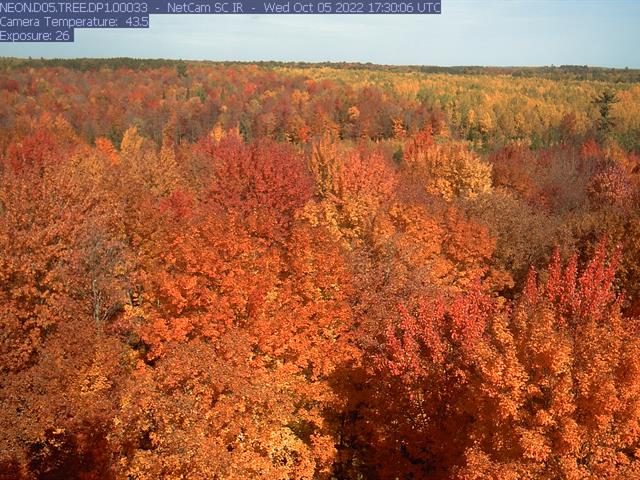
NEON Tower Used In Space-Based Forest Observation Project
Through the use of NEON tower sensors, NASA research scientist Jon Ranson and his team have made significant progress in their efforts to study trees from space and gained a better understanding of their impact on atmospheric carbon dioxide levels and climate change. By utilizing hyperspectral imaging technology and drones fitted with specialized cameras and equipment, the team has been able to accurately assess forest health and calculate the amount of carbon that forests remove from the atmosphere. With the goal of studying forests on a global scale, the team has developed a satellite mission concept known as CASALS, which is equipped with lidar and hyperspectral cameras to take frequent measurements of changes in forest productivity over time. In order to refine their techniques and identify sources of error, the team collected imaging data over forests in Mountain Lake, VA, and compared it with actual CO2 levels recorded by sensors on a nearby NEON tower.
Originally published in the April 2023 edition of the NEON Spotlight
NEON Data Reveals Ground Beetles' Response to Climate Change
Penn State researchers have found that the response of ground beetles to climate change in North America will largely depend on their species' traits and habitats, with some species thriving while others decline. The team studied 136 ground beetle species found in diverse habitats across North America, Puerto Rico, and Hawaii using data collected from NEON. They found that less mobile, nonflying beetle species could decline over time in a warmer, drier climate; however, habitat conservation can mitigate the effects of climate change and reverse the trend in some areas. Ground beetles are natural predators of many agricultural pests, including slugs, snails, cutworms, and root maggots, and help reduce the need for synthetic pesticides. Any decline in their populations could lead to an increase in pest populations and subsequent crop damage. This research suggests that conservation efforts focused on preserving habitats for these beetles may help mitigate the effects of climate change on pest control in agriculture.
Originally published in the May 2023 edition of the NEON Spotlight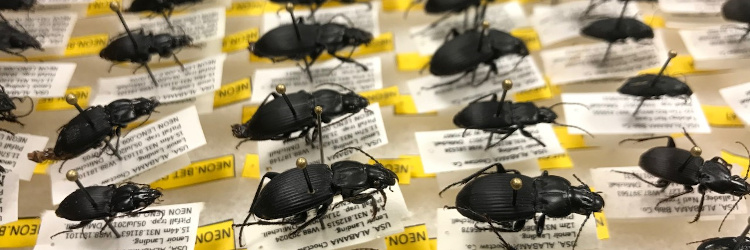
NEON Observations Play Role in Tree Mortality Study
Ecologists from University of California, Irvine conducted a study on two NEON sites within the Sierra Nevada region, aiming to investigate tree mortality and its association with various environmental factors. The study used NEON’s lidar and multispectral reflectance airborne observations to map individual tree mortality over a 160 km2 area during and after the 2012–2016 drought. The findings revealed a significant correlation between tree mortality and two key variables: distance from rivers and tree height. The study also found a positive correlation between tree mortality and decreasing slope at lower elevations and increasing slope at higher elevations. The findings from this study will help identify risk factors for tree mortality and design effective conservation strategies as extreme drought becomes more common due to climate change.
Originally published in the June 2023 edition of the NEON Spotlight
NEON Inspires New Phenocam at Furman University
Inspired by NEON, a student has installed a phenocam at Furman University that captures seasonal changes in tree canopy development, or phenology. Emily Gardella, an Earth and environmental sciences major, introduced the phenocam as part of her independent study accessing NEON data. Furman now joins just one other South Carolina university in the global PhenoCam Network, which encompasses approximately 700 sites worldwide and partners with NEON. This new compact phenocam continuously captures images every half hour throughout the year, transmitting the data to the network's server. Gardella utilized this valuable data to investigate landscape resilience after natural disasters, such as wildfires, underscoring the importance of monitoring climate variations and their future impacts. By actively participating in the PhenoCam Network, the university not only contributes to climate change research but also gains insights into its own local phenology and ecological changes over time.
Originally published in the July 2023 edition of the NEON Spotlight
-(1)-tmb-blog-crop-jpg.jpg?sfvrsn=7a848943_0)
NEON Infrastructure Aids First Long-term Aerosol Study in U.S.
Scientists from a variety of academic institutions have begun leveraging NEON infrastructure for a new NSF-funded multistate project to determine the chemical content and physical properties of airborne particulate matter. The project, named The Atmospheric Science and Chemistry Measurement Network, has created the nation’s first long-term network of monitoring stations on aerosol chemical content and properties. The sensors will allow scientists to accurately assess and predict the impact of aerosols on climate, human health, visibility, and ecosystems in a changing environment. The installation of the air quality sensors at NEON’s Delta Junction site in Alaska was made possible through the NEON Assignable Assets Program which makes certain components of NEON's infrastructure available to members of the community to support their own research or other activities.
Originally published in the August 2023 edition of the NEON Spotlight
NEON Data Essential to Quantifying Material and Energy Exchange Between Ecosystems and Atmosphere
Researchers used point cloud lidar data from NEON, covering 12 forest types across the United States, to assess the accuracy of Global Ecosystem Dynamics Investigation’s effective leaf area index (GEDI LAIe), which evaluates energy exchanges between terrestrial ecosystems and the atmosphere. The reference datasets of NEON lidar GEDI LAIe are environmentally distributed over the continental United States, which spans 17 eco-climatic geographic units and contains rich forest types. The findings validate that GEDI LAIe is generally an accurate tool, but also identify factors (e.g., forest type) with the potential to impact its measurements.
Originally published in the September 2023 edition of the NEON Spotlight-tmb-blog-crop-jpg.jpg?sfvrsn=7776d575_0)
NEON Data Used to Evaluate Point-Cloud Denoising Algorithms Accuracy
In this study, researchers used NEON airborne data compared with an ICESat-2 simulator’s data to verify the denoising accuracy and adaptability of three algorithms. The first is NASA’s differential regressive and Gaussian adaptive nearest neighbor (DRAGANN) algorithm. The second is Herzfeld’s radical basis function (RBF) algorithm, and the third is the density-based spatial clustering of applications with noise (DBSCAN) algorithm. The results show that the DRAGANN and DBSCAN algorithms are suitable at night for moderate vegetation coverage and are not affected by terrain slopes. However, the DBSCAN algorithm is greatly affected by solar noise photons, but at night, its denoising accuracy is higher than that of the DRAGANN algorithm. The RBF algorithm accuracy is suitable for all day data but decreases with increasing slope and vegetation coverage.
Originally published in the October 2023 edition of the NEON Spotlight
NEON Sites and Data Help Measure Forest Fire Carbon Release
Fire ecologist Dr. Jennifer Balch from the University of Colorado Boulder used NEON infrastructure and data to study how forests recover after wildfires and their contribution to carbon levels in the atmosphere. Balch and her team used NEON’s Airborne Observation Platform as well as light detection and ranging data (lidar) from NASA’s Global Ecosystem Dynamics Investigation (GEDI). GEDI uses an instrument with lasers to build three-dimensional forest maps. With these tools, the researchers are better able to understand the carbon cycle of the Earth and the amount stored and lost from disturbed forests. The NEON and NASA resources allow Balch and her team to study data from over 600 fires that have burned over 1,000 acres and better understand the impacts of wildfires on climate change.
Originally published in the November 2023 edition of the NEON Spotlight
Related Blogs
BATTELLE UPDATES
Receive updates from Battelle for an all-access pass to the incredible work of Battelle researchers.
